All seats in poker are not created equal! That’s not to say that there are lucky seats. That’s superstitious nonsense. But your poker position definitely matters.
In this guide, pro poker player and blogger Ashley Adams will teach you the topic of position, explaining how different positions at the poker table should affect how you play your hands.
The goal is to provide a complete guide to poker positions to demystify the subject for everyone.
Here's what you'll learn:
By the end of this guide, you will understand the strengths and weaknesses of the different positions at the poker table.
Take a seat!
Much of the way you play a poker hand, including whether you play it at all or fold right off the bat, is determined by where you are sitting – relative to the dealer and relative to the other players at the poker table.
This is known as your position. It is the most critical factor to consider, other than the cards themselves. In this explanatory piece, I will explain exactly how the position should affect whether and how you play a hand.
Simply put, a poker position is your place at the poker table relative to the dealer and relative to other active players.
It’s best to view this in a diagram, provided below:
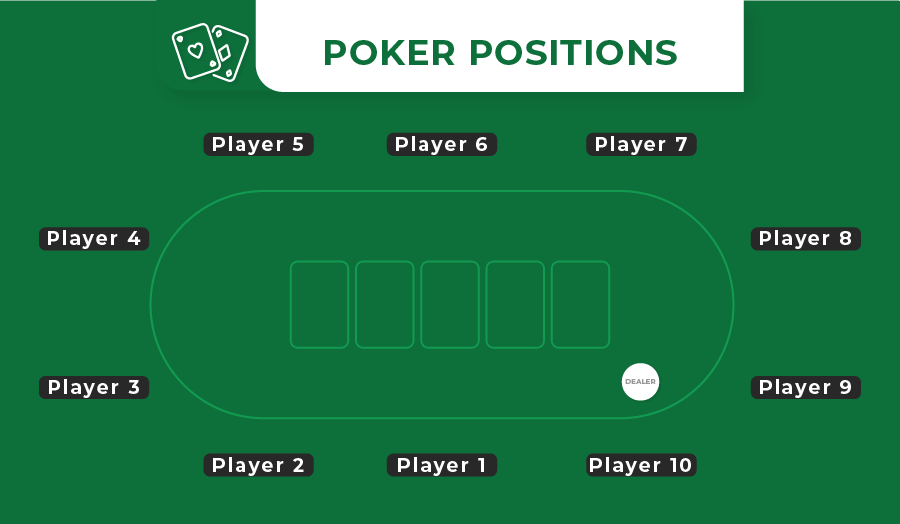
In this diagram of a typical, 10-person poker table, each seat is numbered from 1 to 10, moving clockwise around the table.
The 1 seat is the seat immediately to the left of the dealer. The 2 seat is to their left, etc.
This numbering continues all the way to the 10 seat. This is referred to as “The Button” (B), and it is the dealer position.
Fun Fact
While 99.9% of the poker world counts poker positions clockwise, starting to the left of the dealer, there are a tiny percentage of rooms that GO THE OTHER WAY and number the seats, and deal each player counterclockwise, beginning to the right of the dealer.
In a typical home game, players may deal for themselves, in which case the person who is literally dealing the cards is considered the dealer, and has last action.
Players act sequentially, beginning with the player to the left of the dealer.
However, in a casino or other public poker room, there is typically a professional dealer supplied by the house, who deals all of the cards every hand, gathers in the discards, awards the pot, gathers in a rake or a time charge, and acts as the manager of the game.
When that is the case, there is a dealer button that is placed in front of one player for each deal.
That dealer button rotates clockwise around the table after every hand, designating a different player as the dealer each hand, with each seat designation changing each hand accordingly.
The player to the left of that dealer button is always designated as being in the 1 seat.
The player with the dealer button is always designated as being in the 10 seat (in a ten-handed game). If there are fewer than 10 players, the dealer is the highest number of seated players.
The player to their left is always in the 1 seat.
In nearly all public poker rooms, the 1st seat is the small blind (SB) and the 2nd seat is the big blind (BB).
Fun Fact
There are still a few games that are dealt with only one blind. When that is the case, it is designated the big blind (BB) and the 2 seat is UTG.) The rest of the seats have other names and initials as well, to go along with their numeric designation.
We’ll look at those names below.
Here are the commonly accepted poker positon names:
- The 3rd seat is known as being Under-the-Gun (UTG);
- The 4th seat , which is the one following UTG is known simply as UTG+1;
- The 5th seat is UTG+2;
- The 6th seat is UTG+3;
- The 7th seat is the lojack (LJ);
- The 8th seat is the hijack (HJ);
- The 9th seat is the cutoff (CO),
- The 10th seat is the dealer, also known as the Button (B).
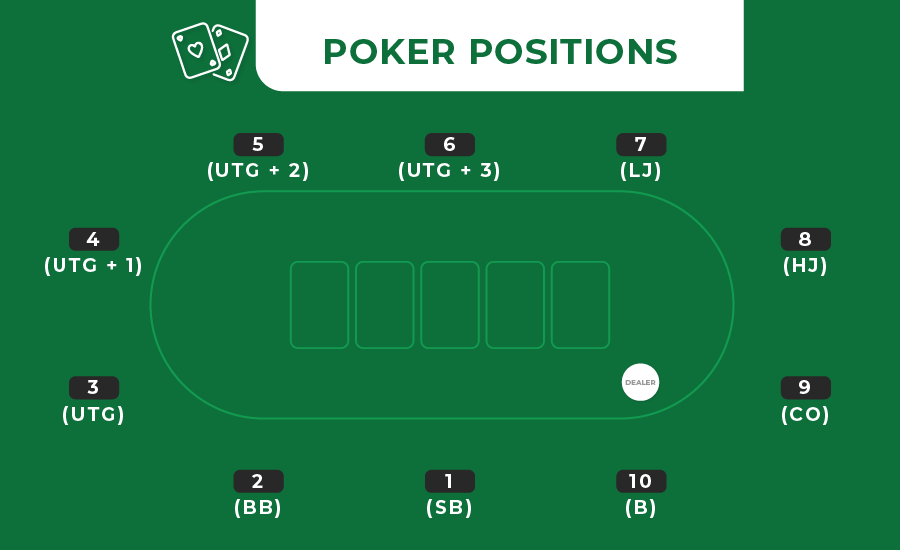
Please note
If the game only seats nine, you take out UTG+3; if only eight, take out UTG+2, if seven, take out UTG+1; if six, take out lojack; if five, take out hijack; if four, take out cutoff, if heads up, it’s just SB, who is also UTG, and BB, who is also the button (B).
Here's a simple chart to make the seating positions and their names easy to visualize.
| Seat Number | Seat Name | Seat Initial | General Position |
| 1 | Small Blind | SB | Early |
| 2 | Big Blind | BB | Early |
| 3 | Under the Gun | UTG | Early |
| 4 | Under the Gun +1 | UTG+1 | Early |
| 5 | Under the Gun + 2 | UTG+2 | Middle |
| 6 | Under the Gun + 3 | UTG+3 | Middle |
| 7 | Lojack | LJ | Middle |
| 8 | Hijack | HJ | Late |
| 9 | Cutoff | CO | Late |
| 10 | Button (Dealer) | B | Late |
Let’s take a look specifically at each of these general positions, and the corresponding strategic considerations for each.
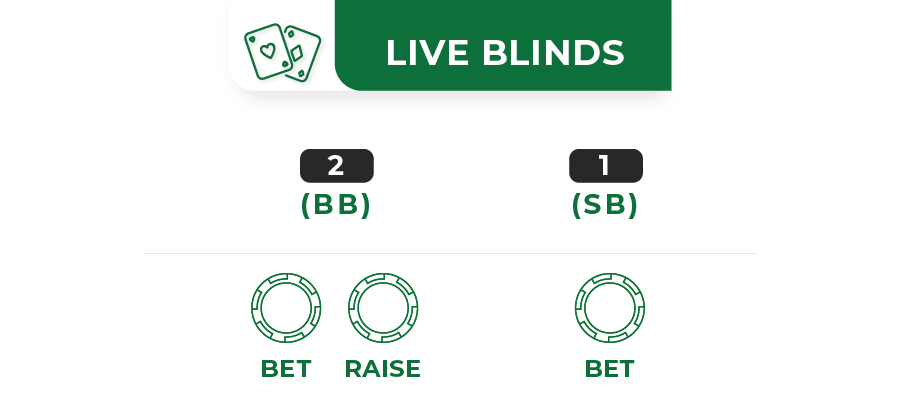
The blinds are particularly interesting because their relative position changes after the flop. Before the flop, the big blind has last betting action.
But after the flop, and for all betting rounds that follow, the small blind and the big blind are in the earliest position.
What Is the Purpose of Blinds in Poker?
The blinds have a unique purpose in poker. They are meant to stimulate and encourage betting action.
In that sense they are much like antes in other forms of poker. They are a forced bet before players know their hands. Their posting of a blind does not indicate strength or weakness, but is just a mandatory pot-builder.
If it weren’t for blinds or antes, players would have no financial reason to contest any pots unless they had the strongest possible hands. Antes provide something of value to fight over before players review and consider their hands.
They are also a cost for inaction – as players must post them even if they don’t compete in the hand. Blinds do the same thing, as they are required before players look at their hands. But they have another purpose as well.
They begin the betting itself.
Players following the blinds cannot check on the first round. They must either call the blind bet, fold, or raise. In this way, betting action is both encouraged and stimulated.
Blinds are Live
Blinds are different from other bets.
Typically, in a poker game, the player who initiates the betting does not have an opportunity to raise unless they themselves are raised.
But with blinds, the player with the big blind retains the ability to raise themself if the pot has not already been raised by the time the betting has gone around the table and returned to them.
For example
Imagine a $2/5 no limit hold’em game. You are the big blind for $5. The game is eight-handed. Two players call you and the rest fold before the action comes back around to you. Though you initiated the betting with your $5, you now have the ability to raise the bet.
That’s called a “live blind”.
Defending your Blind
Blinds are sometimes under attack from players, especially those in late position, who try to take advantage of their position by raising, even with a low valued hand, to steal the blinds by getting the small blind and the big blind to fold.
For example
In the $2/5 game described above, if you are the big blind and five players fold, leaving just the button, the small blind, and you; the button may try to steal the blinds by raising, hoping the small blind and you will fold.
This is a common tactic of players in late position in an unopened pot. If the small blind folds, the big blind must then decide whether to fold or attempt to defend the blind by calling the raiser or by raising.
Many factors should go into your decision of whether or not and how to defend your blind. First of all, you need to consider the strength of your hand.
Against a habitual blind stealer, who will make the attempt with any two cards, you can confidently call or raise withany hand of average strength or better. Generally, that’s considered to be Q7.
Your cards are not the only consideration when deciding whether to defend your blinds. You need to also consider whether the raiser has a history of making aggressive moves in this position.
And you need to think about the image that your opponent has of you – whether you are someone whom they are likely to try to bully, based on your previous action.
Remember
There is no simple counter-measure to suggest for players who may be targeted for blind steals. Sometimes it makes sense to call. Sometimes it makes sense to raise. And sometimes, even if you determine that your opponent is attempting to steal your blind, it makes sense to fold.
Each situation is different. Just be aware that this may happen, and make the best move you can.
Raising from the Blinds
Defending your blinds is a defensive strategy, as we have seen. But sometimes, blinds should play offense. They should not always check an unraised pot.
When should they raise?
In general, blinds should raise to either win the pot or to narrow the field. This may be the case when many players have limped in – calling the big blind.
A BB with a premium pair may want to make a large raise, with the plan to either win all of the limps or to get only one or two callers. The blinds must be mindful that they will have the worst position after the flop, and value their hand accordingly.
On the other hand, the SB or BB might want to check when they have a drawing hand, or a hand that they don’t mind playing against a large field.
Hands that might want to check are Ax-suited or a small pair looking to hit a set.
On the other hand, with a big Ace or a big King, where they want to play only against one or two opponents, or with a premium pair, the blinds may want to raise to knock out many opponents.
Important
Remember that even though the blinds have last position pre-flop, as soon as the flop hits, and for all betting rounds thereafter, they will have the worst position.
They need to consider that when contemplating their action.
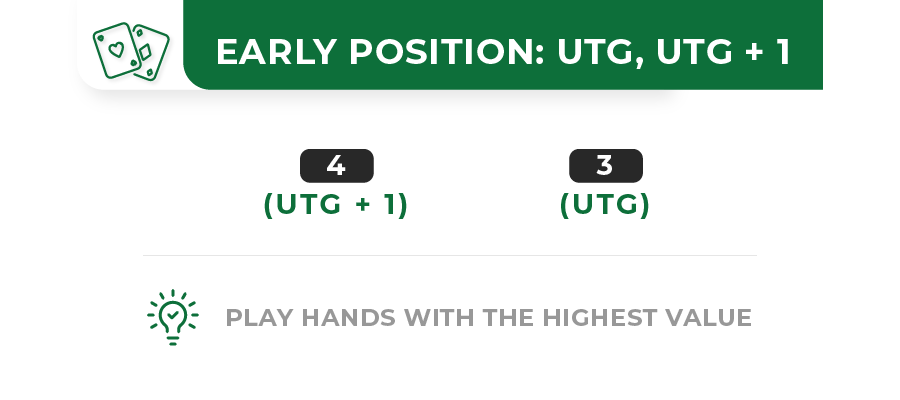
Players in early position are the first to act after the blinds.
These are the players who must first weigh the strength of their hand and decide whether and how to play their hands.
As mentioned in my introduction to hold’em article, players in early position must be especially careful about the hands they play, leaning toward playing only those hands with the highest value. Typically, a player in early position is playing a very narrow range – a small percentage of their cards, such as big pairs and AK.
This is true for many reasons. The most important is that knowledge is power.
Early position players have the least knowledge of the other players, as they do not get to see how they act until they have already acted.
Early position players do not have any indication of the strength of the players yet to act.
If an early position player elects to enter the hand by raising the Big Blind, they run the risk that one of the many remaining players may have a strong hand and 3-bet.
They also have the strategically disadvantage of being in early position, relative to the raiser, for the remainder of the hand.
This limits their ability to see their opponent’s action before deciding on their own action.
It also cedes to their opponent better position, allowing their opponent to see action before deciding on how or whether to continue playing the hand.
Pro tip
The best strategy to follow in early position is to generally play a more narrow range of hands than you would play in middle or late position.
Tend to avoid limping, as it may encourage latter players to raise. And tend to play the few hands you play aggressively, to deter others from passively calling a hand where they will have better position than you for the duration of the hand.
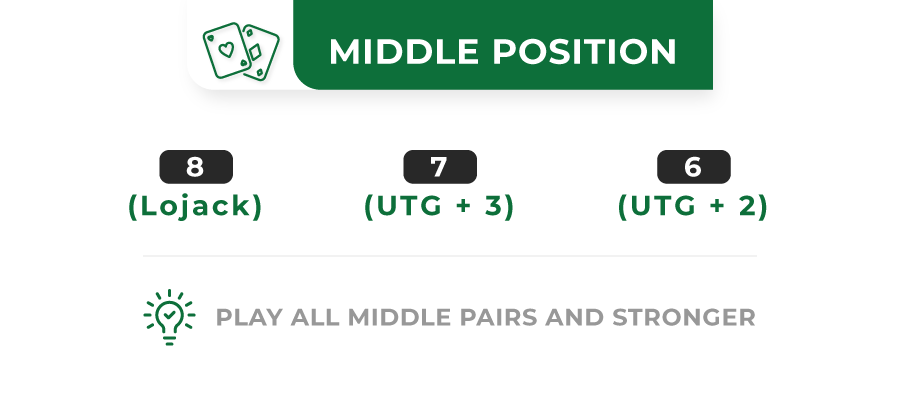
Players may generally enter the hand with a broader range than those in early position; but they can’t play as broad a range of hands as those in late position.
For example
A good tight range for middle position would allow for a player to play all middle pairs and stronger, ATs+, and AK, AQ, and possibly AJ unsuited.
Also, they typically may play KQs, QJs, And JTs.
Their risk of being raised and of having players playing after them in later rounds is smaller than that risk from early position.
Though they still have to be cautious with their range of hands, they don’t have to be as cautious as an early position player.
Middle Position Betting Decisions that Affect Latter Position
Middle position players need to consider the likely affect their betting action will have on their future betting position.
They can, with their bet or raise, often move from their current middle position to late position, by convincing those players after them to fold.
Similarly, a failure to bet or raise, may subject them to being in early position on future betting rounds, as their remaining opponents may limp behind them with a call, retaining their relatively better position as the hand progresses.
Consider this hand, for example:

You are in UTG+3 with Ah Jh. One player calls the big blind; two others fold.
The action comes to you. If you call, it is likely that at least another player will call after you. When the flop comes, you are likely to be in early position relative to that player, putting you at a disadvantage.
On the other hand, if you raise the BB pre-flop, it’s likely that your raise will cause the players after you to fold, leaving you with last position on later streets.
This is known as “buying the button” – as, with the cost of your raise, by knocking out all players after you, it causes you to become, effectively, the button for all future betting rounds. (Of course, you can’t be certain that your betting action will have this affect. But it needs to be a consideration when you decide on what action to take).
One Consideration for Loose Passive Games
Some no limit games, especially with relatively smaller blinds like $1/2 in a public brick and mortar casino room, or $.05/.10 and below in an on-line poker room, have especially loose and passive players.
Most hands don’t have anyone raising the big blind pre-flop.
It is common for four or more players to see the flop for the price of the big blind. When that is the case, some of the disadvantages of early and middle position are diminished.
In games like these, you may lower your standards for entering the hand; and may do what others are doing, limping in with relatively low-quality starting cards.
You can do this for two reasons:
- the large implied odds if you do hit your hand;
- the unlikelihood that you will be faced with a raise after you limp.
Even so, you must be prepared to throw your hand away if someone does unexpectedly raise. And you must be able to get away from your hand after the flop if you don’t hit the hand you were aiming to hit.
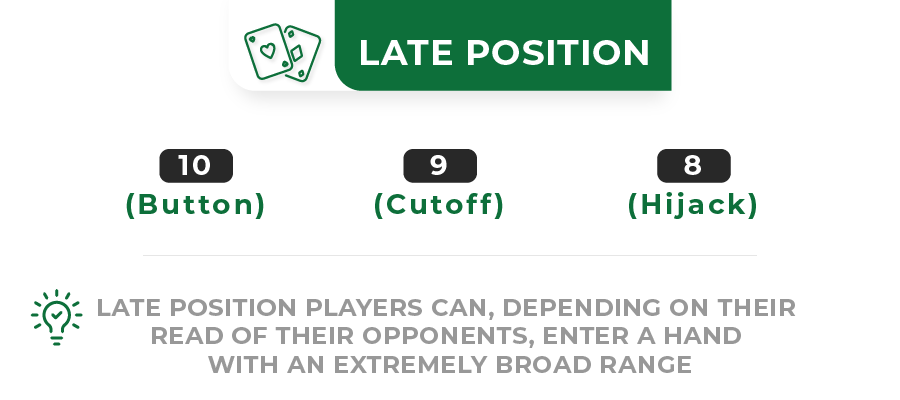
Late position has the advantage of seeing the action of other players, before having to decide on their own betting action.
Since knowledge is power, and seeing how others act is knowledge, this is the most powerful position.
Late position is useful for a few reasons:
First and foremost, the play of other is a window into the likely strength of their hand. An early position player who raises, is likely to have a very strong hand.
A player who calls is likely to have some doubts about the strength of their hand (otherwise they would have raised).
Players who fold are no longer any threat to raise. And, being in late position continues for all four betting rounds; allowing the late position player to take advantage of their position throughout the hand.
Because of this, the standards for entering a hand are lower than in either middle or early position.
Late position players can, depending on their read of their opponents, enter a hand with an extremely broad range.
If no one has yet raised, they may play hands as seemingly weak as medium one and two-gap suited connectors, Ax-suited, Kx-suited, Q9+, and all pairs.
Also, as they themselves are unlikely to be raised, since the only players remaining after late position are the blinds, they may safely limp into a hand if the pot has not yet been raised
Similarly, late position players can open up their range for 3-betting – that is, raising raisers.
For example
If the pot has already been raised, a late position player, assured of late position throughout the hand, might 3-bet with not just the big premium pair hands like QQ+, but also add in TT and JJ, AK, AQs, AJs, and maybe even KQs.
I’m not saying you must always 3-bet with those hands in late position, but because of your position, you might want to do so on occasion.
We have been discussing absolute position, as a function of seating position. But it’s critical to realize that all position is relative.
If I am in the 9 seat, that is late position using absolute considerations as described above.
But if I am in a hand and playing against the 10 seat, then my 9 seat is in early position, with all of the attendant disadvantages.
You must completely re-evaluate your position on the flop and on each street thereafter, based on where you sit relative to the other players still in the hand. Your action needs to reflect your consideration of that position.
Let's take this situation as an example:
Suppose you started in the 9 seat, and after the flop found yourself heads up against the button. In that case you must proceed more cautiously than if you and the 8 seat remained.
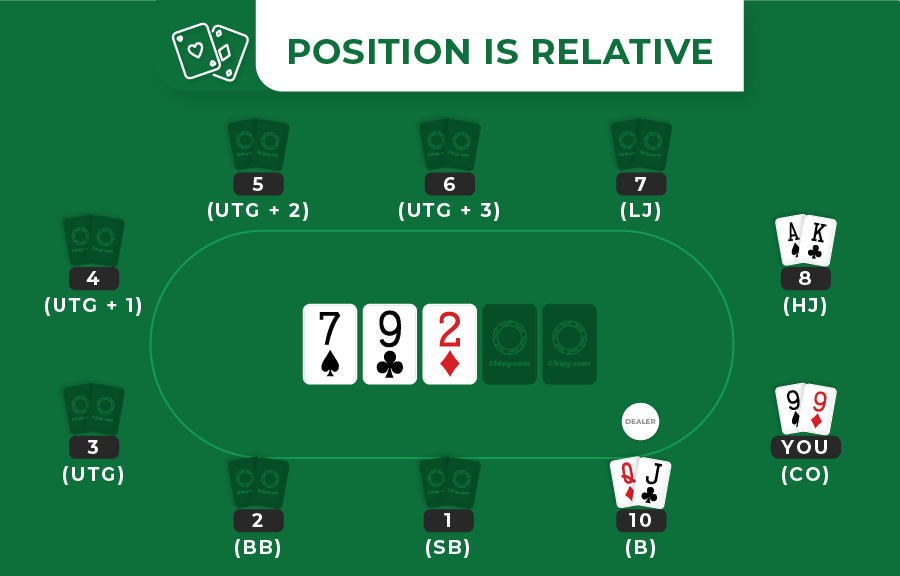
Against the 10 seat you will have early position for the remainder of the hand.
If you bet you may be raised.
If you check, your opponent may interpret your check as a weakness and bet with a very broad range of hands.
Or they may check behind you and get a free card.
If you check, your opponent may also be more inclined to bluff, seeing your initially weak action.
Similarly, if you are in the 9 seat and are called by a player who limped and who is in the 8 seat, you will have position on them.
Your betting action needs to take that into consideration as well.
You may be more aggressive when they check and you perceive them to be weak.
You may also elect to check behind them, knowing that your check will end the action – and that they may not bet in that round after your bet.
You’ll also know that you will be able to see how they bet before you have to act on each of the subsequent streets.
There are many advantages to late position and disadvantages to early position.
Taken as a whole, they are the reasons you can play a broader range in late position than early position.
I list them for you here:
Disadvantage of Late Position
- An opening bet or raise is more likely to be suspect as a bluff because of the advantageous position.
- A check-raise is not possible (if the pot is heads up).
Advantages of Late Position
- You get to see your opponents’ action before you act
- You can end the action by checking behind your opponent
- You can raise your opponent’s opening bet
- You can better estimate the pot odds when you bet
- Your opponent doesn’t get to see your action when they act initially.
Disadvantage of Early Position
- You have no indication of the strength of your opponents’ hand before you have to act.
- Your bet may be raised
- You cannot close the action with your initial betting action.
Even with all of these advantages of late position and disadvantages of early position, early position does have some advantages – though they are not as numerous or significant as those in late position.
Advantages of Early Position
- An opening bet or raise is generally given more credit than a bet or raise from later position
- You can check-raise from early position.
- You can more easily trap an opponent by feigning weakness by checking a very strong hand.
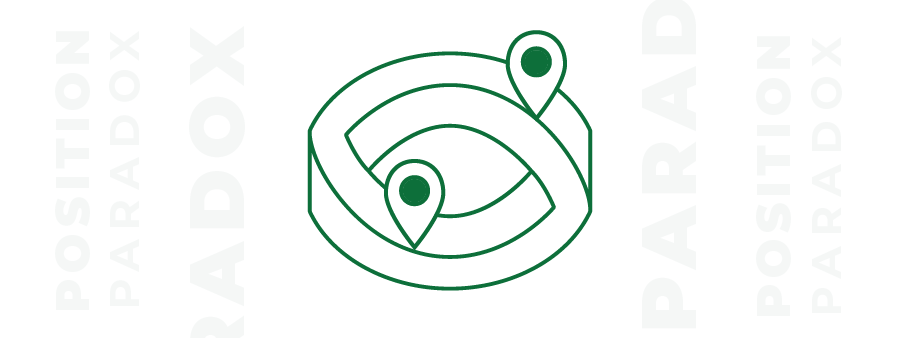
While it is true that later position is generally better than early position, as it gives an opponent more opportunities for bluffing, stealing pots, and playing a wider range of hands;
It is also true that opponents who are at least good understand the value of position, and may take it into consideration when viewing your actions.
This creates a paradox.
Later position is advantageous, but because your opponent knows that, they may be more likely to take countermeasures that will diminish the advantage and cause you more confusion.
Consider a hand when you are on the button. The betting action is not raised, and all players after the blind fold. You have a hand like T6. It’s pretty much a trash hand. But since you’re on the button, you raise 3BB in an attempt to steal the blinds.
Now imagine that you have a very good opponent.
He understands position. He knows that your latter position might well encourage you to try and steal the blinds with a weak hand. Accordingly, because of your late position, he may discount your raise, assume you are on a steal, and either call with a wide range or 3-bet you with a wide range, in an attempt to re-steal.
As you can see, though in general, later position is advantageous, and players in later position may play a wider range than those in earlier position, the matter of position can cut both ways.
Same thing with early position. Early position is generally disadvantageous.
However, because of this, a bet from early position may be more respected as indicating strength than a later position bet.
Ironically, you may be better able to steal a hand from early position than from later position, as your opponents, knowing early position tends to have a tighter range, are more likely to believe your bet indicates real power than a similar bet from late position.
Conclusion
Poker positions matter.
Your ability to play hands depends, at least in large measure, on where you are sitting at the table relative to the dealer.
In general, the earlier the position, the stronger your cards need to be to justify your betting action.
You need to consider not just your absolute position – where you are seated relative to the dealer, but also where you are seated relative to the other active players in the hand.
Still, position is just one piece of the puzzle. If you really want to master the game I highly recommend checking my other Academy guides on poker, and, of course, train hard!

Bonuses
Casinos
Games
Academy
News
Shop
NEW Q&A
Sweepstakes




























